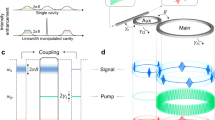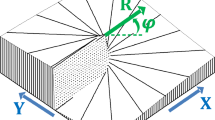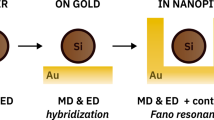Abstract
A new approach for diffracting the weak probe beam into higher-order directions is proposed via electromagnetically induced grating in second field quantization formalism, offering a new way for implementations of quantum information with semiconductor quantum dots. The formalism of second field quantization allows describing atoms and photons as a many-body system. An induced diffraction grating is formed based on the electromagnetic induced transparency when a standing-wave coupling field is applied to a spherical quantum dot as a three-level system. Due to phase modulation, the zeroth-order light intensity becomes weak, and the first-order diffraction is improved affectedly. On the contrary, the probe beam is barely diffracted via absorption modulation. The simulation results verify that photon numbers of probe and control fields, as well as other parameters in the QD, can lead to the diffraction efficiency of phase grating to be improved. Phase diffraction grating accompanied with a high transmissivity is demonstrated, and the first-order diffraction efficiency reaches \(30\%\). Also, the impact of QD dimensions on its optical response is investigated. This model may find potential applications in designing the semiconductor quantum dot-based photonic devices in optical communications and quantum information networks.








Similar content being viewed by others
References
Agarwal, G.S., Huang, S.: Nanomechanical inverse electromagnetically induced transparency and confinement of light in normal modes. New J. Phys. 16, 033023 (2014)
Antón, M.A., Calderón, O.G., Carreño, F.: Optical bistability in V-type atoms driven by a coherent field in a broadband squeezed vacuum. Phys. Lett. A 311, 297–312 (2003)
Banyai, L., Koch, S.W.: Semiconductor Quantum Dots. World Scientific Publishing Co. Pte. Ltd, Singapore (1993)
Barettin, D., Houmark, J., Lassen, B., Willatzen, M., Nielsen, T.R., Mørk, J., Jauho, A.-P.: Optical properties and optimization of electromagnetically induced transparency in strained InAs/GaAs quantum dot structures. Phys. Rev. B 80, 235304 (2009)
Deng, L., Payne, M.G., Garrett, W.R.: Electromagnetically-induced-transparency-enhanced Kerr nonlinearity: beyond steady-state treatment. Phys. Rev. A 64, 023807 (2001)
Doi, M.: Second quantization representation for classical many-particle system. J. Phys. A Math. Gen. 9(9), 1465 (1976)
Heinze, G., Hubrich, Ch., Halfmann, T.: Stopped light and image storage by electromagnetically induced transparency up to the regime of one minute. Phys. Rev. Lett. 111, 033601 (2013)
Huang, S., Agarwal, G.S.: Electromagnetically induced transparency with quantized fields in optocavity mechanics. Phys. Rev. A 83, 043826 (2011)
Kang, H., Kim, J.S., Hwang, S.I., Park, Y.H., Ko, D.K., Lee, J.: Electromagnetically induced transparency on GaAs quantum well to observe hole spin dephasing. Opt. Express 16, 15728−15732 (2008)
Liu, H., Ren, G., Gao, Y., Zhu, B., Li, H., Wu, B., Jian, Sh: Ultrafast and low-power all-optical switch based on asymmetry electromagnetically induced transparency in MIM waveguide containing Kerr material. Opt. Commun. 353, 189–194 (2015)
Liu, Y-Ch., Li, B.-B., Xiao, Y.-F.: Electromagnetically induced transparency in optical microcavities. Nanophotonics 6(5), 789–811 (2017)
Lvovsky, A., Sanders, B.C., Tittel, W.: Optical quantum memory. Nat. Photonics 3, 706–714 (2009)
Ma, S.-M., Xu, H., Ham, B.S.: Electromagnetically-induced transparency and slow light in GaAs/AlGaAs multiple quantum wells in a transient regime. Opt. Express 17, 14902−14908 (2009)
Marcinkevičius, S., Gushterov, A., Reithmaier, J.P.: Transient electromagnetically induced transparency in self-assembled quantum dots. Appl. Phys. Lett. 92, 041113 (2008)
Miles, J.A., Simmons, Z.J., Yavuz, D.D.: Subwavelength localization of atomic excitation using electromagnetically induced transparency. Phys. Rev. X 3, 031014 (2013)
Naseri, T.: Investigation of dual electromagnetically induced grating based on spatial modulation in quantum well nanostructures via biexciton coherence. Laser Phys. 27, 045401 (2017)
Naseri, T.: Optical properties and electromagnetically induced grating in a hybrid semiconductor quantum dot-metallic nanorod system. Phys. Lett. A 384(7), 126164 (2020)
Naseri, T., Hatami-Mehr, M.: Investigating tunable bandwidth cavity via three-level atomic systems. Eur. Phys. J. Plus 134, 529 (2019)
Naseri, T., Moradi, R.: Realization of electromagnetically induced phase grating and Kerr nonlinearity in a graphene ensemble under Raman excitation. Superlattices Microstruct. 101, 592–601 (2017)
Naseri, T., Asadpour, S.H., Sadighi-Bonabi, R.: Some optical properties of four-level media via coherent and incoherent pumping fields. JOSA B 30(3), 641−648 (2013)
Phillips, M.C., Wang, H.: Exciton spin coherence and electromagnetically induced transparency in the transient optical response of GaAs quantum wells. Phys. Rev. B 69, 115337 (2004)
Proite, N.A., Simmons, Z.J., Yavuz, D.D.: Observation of atomic localization using electromagnetically induced transparency. Phys. Rev. A 83, 041803(R) (2011)
Qamar, R., Qamar, S.: Two-dimensional atom localization via probe-absorption spectrum. Phys. Rev. A 90, 039901 (2014)
Raki, Z., Askari, H.R.: Investigation of electromagnetically induced transparency in quantum dots by using second quantization formalism. Opt. Laser Technol. 112, 508–513 (2019)
Sadighi-Bonabi, R., Naseri, T.: Theoretical investigation of electromagnetically induced phase grating in RF-driven cascade-type atomic systems. Appl. Opt. 54(11), 3484–3490 (2015)
Sahrai, M., Abbasabadi, M.: All-optical switch based on doped graphene quantum dots in a defect layer of a one-dimensional photonic crystal. Appl. Opt. 57, 521–6 (2018)
Schmidt, H., Ram, R.J.: All-optical wavelength converter and switch based on electromagnetically induced transparency. Appl. Phys. Lett. 76, 3173−3175 (2000)
Wang, Zh, Yu, B.: Optical bistability and multistability via dual electromagnetically induced transparency windows. J. Lumin. 132(9), 2452–2455 (2012)
Woggon, U.: Optical Properties of Semiconductor Quantum Dots. Springer, Berlin (2014)
Wu, H., Xiao, M.: White-light cavity with competing linear and nonlinear dispersions. Phys. Rev. A 77, 031801(R) (2008)
Xu, J., Al-Amri, M., Yang, Y., Zhu, Sh-Y, Zubairy, M.S.: Wide-band optical switch via white light cavity. Phys. Rev. A 86, 033828 (2012)
Yamamoto, Y., Tassone, F., Cao, H.: Semiconductor Cavity Quan Electrodynamics. Springer, Berlin (2000)
Yang, X., Li, Sh, Zhang, Ch., Wang, H.: Enhanced cross-Kerr nonlinearity via electromagnetically induced transparency in a four-level tripod atomic system. JOSA B 26(7), 1423–1434 (2009)
Zhang, S., Zhou, S., Loy, M.M.T., Wong, G.K.L., Du, S.: Optical storage with electromagnetically induced transparency in a dense cold atomic ensemble. Opt. Lett. 36, 4530−4532 (2011)
Author information
Authors and Affiliations
Corresponding author
Additional information
Publisher's Note
Springer Nature remains neutral with regard to jurisdictional claims in published maps and institutional affiliations.
Appendix: The derivation of the induced dipole moments of the QD
Appendix: The derivation of the induced dipole moments of the QD
By applying the spherical potential for the QD with radius \(R_{s}\), its unperturbed Hamiltonian is written as
here \(m_{e}^{*}\) is the effective mass of electron, r is the spherical radial coordinate, \(\omega _{0} = \hbar /(2m_{e}^{*}R_{s}^{2})\) is the electron oscillation frequency in the direction of QD radius and \(k = \sqrt{m_{e}^{*}\omega _{0}/\hbar ^{2}}\) is the effective wave number.
By considering the separation of variables method, eigenfunction of the Hamiltonian \(H_{0}\) can be calculated as
where \(n_{i} (i =1,2,3)\) are quantum numbers and \(H_{n_{i}}(x_{i})\) the \(n_{i}\)th Hermitian polynomial. The eigenvalues of \(H_{0}\) is also obtained by
By considering the forbidden and allowed transitions,The induced dipole moments for transitions \(|{1}\rangle \leftrightarrow |{2}\rangle (\mu _{12})\) and \(|{1}\rangle \leftrightarrow |{3}\rangle (\mu _{13})\) are calculated as
where erf(x) is the error function.
Rights and permissions
About this article
Cite this article
Naseri, T. Electromagnetically induced grating with second field quantization in spherical semiconductor quantum dots. Opt Quant Electron 52, 252 (2020). https://doi.org/10.1007/s11082-020-02358-w
Received:
Accepted:
Published:
DOI: https://doi.org/10.1007/s11082-020-02358-w




